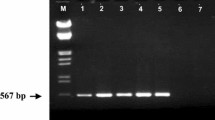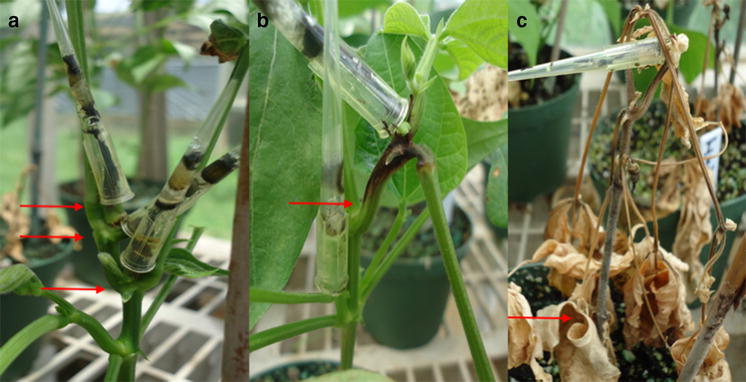Abstract
Ascochyta blight resistance in Pisum sativum (field pea), P. fulvum and Lathyrus species was examined in glasshouse experiments using an isolate of the fungal pathogen Mycosphaerella pinodes that had been isolated from field pea. In the genus Pisum there was significant variation in stem infection among the primitive field pea lines, the field pea cultivars and the P. fulvum lines. Two P. fulvum lines and one primitive field pea line exhibited significantly less stem infection than the two field pea cultivars. Leaf infection of the primitive field pea lines was not significantly different from that of the field pea cultivars. P. fulvum accession PS1115 had the least stem infection and the least leaf infection among the Pisum germplasm. Examination of stem infection in Lathyrus showed that L. sativus, L. ochrus and L. clymenum accessions were significantly more resistant to stem infection than the field pea cultivars. Six of the eight accessions of Lathyrus were also significantly more resistant to leaf infection than the field pea cultivars. Among ten accessions of L. sativus, there was significant variation in severity of stem infection but not leaf infection. This is the first report comparing ascochyta blight resistance between Lathyrus and Pisum species and among Lathyrus accessions and the results show that Lathyrus species may be a source of resistance alleles that could be exploited to develop ascochyta blight resistance in field pea.
Similar content being viewed by others
References
Ali SM, Nitschke LF, Dubé AJ, Krause MR, Cameron B (1978) Selection of pea lines for resistance to pathotypes of Ascochyta pinodes, A. pisi and Phoma medicaginis var. pinodella. Australian Journal of Agricultural Research 29, 841–849.
Bretag TW (1991) Epidemiology and control of ascochyta blight of field peas. PhD Thesis, La Trobe University.
Bretag TW, Keane PJ, Price TV (1995) Effect of ascochyta blight on the grain yield of field peas (Pisum sativum L.) grown in southern Australia. Australian Journal of Experimental Agriculture 35, 531–536.
Campbell CG, Mehra RB, Agrawal SK, Chen YZ, Abd El Moneim AM, Khawaja HIT, Yadov CR, Tay JU, Araya WA (1994) Current status and future strategy in breeding grasspea (Lathyrus sativus). Euphytica 73, 167–175.
Clulow SA, Lewis BG, Matthews P (1991) A pathotype classification for Mycosphaerella pinodes. Journal of Phytopathology 131, 322–332.
Croft AM, Pang ECK, Taylor PWJ (1999) Molecular analysis of Lathyrus sativus L. (grasspea) and related Lathyrus species. Euphytica 107, 167–176.
Durieu P, Ochatt SJ (2000) Efficient intergeneric fusion of pea (Pisum sativum L.) and grass pea (Lathyrus sativus L.) protoplasts. Journal of Experimental Botany 51, 1237–1242.
Farr DF, Bills GF, Chamuris GP, Rossman AY (1989) ‘Fungi on plants and plant products in the United States.’ (The American Phytopathological Society: St Paul USA)
Lawyer AS (1985) Foliar diseases caused by fungi: diseases caused by Ascochyta spp. In ‘Compendium of pea diseases.’ (Ed. DJ Hagedorn) pp. 11–15. (The American Phytopathological Society: St Paul USA)
NIAB (1985) Key No. 32. Downy mildew. In ‘Disease assessment manual for crop variety trials.’ (National Institute of Agricultural Botany, Cambridge, England)
Pang E, Brown J (1992) Transferring useful traits from Lathyrus sp. to field pea (Pisum sativum L.). Proceedings of the Field Pea Breeding Workshop, October 1993, Horsham, Victoria. (Ed. JB Brouwer) (Victorian Institute of Dryland Agriculture: Horsham, Vic.)
Punithalingam E, Holliday P (1972) Mycosphaerella pinodes. In ‘CMI Descriptions of pathogenic fungi and bacteria. No. 340:1–2’. (Commonwealth Mycological Institute, Kew, Surrey)
Schroeder HE, Schotz AH, Wardley-Richardson T, Spencer D, Higgins TJV (1993) Transformation and regeneration of two cultivars of pea (Pisum sativum L.). Plant Physiology 101, 751–757.
Warkentin TD, Rashid KY, Xue AG (1996) Fungicidal control of ascochyta blight of field pea. Canadian Journal of Plant Science 76, 67–71.
Weimer JL (1947) Resistance of Lathyrus spp. and Pisum spp. to Ascochyta pinodella and Mycosphaerella pinodes. Journal of Agricultural Research 75, 181–190.
Wroth JM (1996) Host-pathogen relationships of the ascochyta blight (Mycosphaerella pinodes (Berk. & Blox.) Vestergr.) disease of field pea (Pisum sativum L.). PhD Thesis, University of Western Australia.
Wroth JM (1998a) Possible role for wild genotypes of Pisum spp. to enhance ascochyta blight resistance in pea. Australian Journal of Experimental Agriculture 38, 469–479.
Wroth JM (1998b) Variation in pathogenicity among and within Mycosphaerella pinodes populations collected from field pea in Australia. Canadian Journal of Botany 76, 1955–1966.
Author information
Authors and Affiliations
Corresponding author
Rights and permissions
About this article
Cite this article
Gurung, A.M., Pang, E.C.K. & Taylor, P.W.J. Examination of Pisum and Lathyrus species as sources of ascochyta blight resistance for field pea (Pisum sativum). Australasian Plant Pathology 31, 41–45 (2002). https://doi.org/10.1071/AP01069
Received:
Accepted:
Issue Date:
DOI: https://doi.org/10.1071/AP01069




